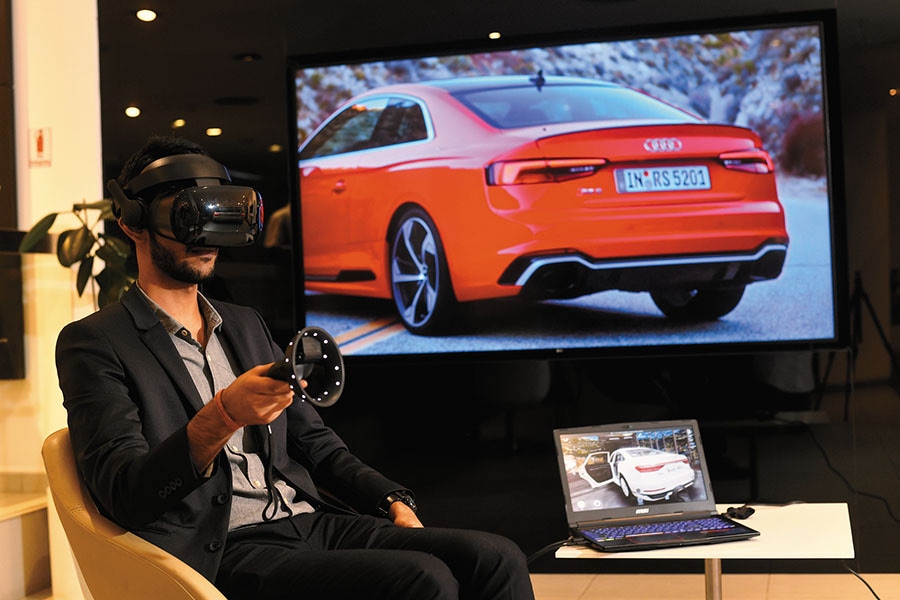The internet of indulgence
India's luxury consumers are getting bored of monotonous, age-old user experiences. Brands are conjuring up exclusivity through AI/AR-VR to hyper-personalise and add that bit of 'magic'


Audi India is using virtual reality to give customers a touch-and-feel experience of the A8L, which is making a delayed entry into India[br]A smattering of pastel houses rises above an inky ocean, peeking from beyond the French windows. I take a seat into the car’s expansive backseat, as instructed, and with the flick of a finger, the seat in front of me has zoomed forward and bent over, adding extra legroom—and a surprise. A plate from the seat back folds out, much like an airplane table, revealing a cushioned footrest. Here, at the rear of the Audi A8L, I have a plush, on-demand foot massager, complete with heating controls.
As I sink into the seat, though, I remember a slight technicality—I can’t actually get that massage. The truth is that beyond those French windows isn’t the oasis of blue, but rain pelting down a raucous Mumbai road. For a few minutes, though, I was ‘in’ the car somewhere in France, not on a regular leather chair at a store, and could physically walk around the car to get a sense of its size, or of how it looks in the metallic Navarra Blue versus the muted Impala Beige.
The A8L has been late in coming to India, so the Audi team has devised a high-tech sales experience to keep up the buzz and speed up the pre-order process. It’s snazzy and elaborate, and locally built. Rather effective too.
I’ve played with virtual reality (VR) headsets before and was a bit sceptical putting these on yet, I had to stop myself from reaching out to pat the seat leather, the colour of which I had just changed to an elegant burgundy. I could see each stitch detailing and feel the manufactured luxury of the car, without it being even on the same continent as me. It felt like I could do pretty much everything but drive it.
“Digital customer-centric initiatives are a key focus area for Audi in India,” says Balbir Singh Dhillon, head of Audi India. “In today’s connected world, we want our customers to experience every detail of the car in miniature or actual size from the comfort of their home or office environment this is possible through virtual and augmented reality (AR). Through these new-age solutions, a customer can experience what the brand truly stands for: Vorsprung durch Technik, or ‘progress through technology’.”
Audi’s VR experience—which is supplemented with an augmented reality set up on an iPad as well—is part of a new era of luxury business driven by high-end technology. For the discerning set of high net-worth individuals in India, brands are working to engage touch points that offer next-level convenience and tell unique stories. The eventual goal is to tailor every touch point for each customer. A lot of this process is driven by technology and artificial intelligence (AI), and then built upon to lend that clutter-breaking wow factor.
“Over the past few years, the quality of data available has significantly improved,” says Manishi Sanwal, managing partner of data analytics firm Voiceback Technologies, who has previously worked in leadership roles at LVMH in India and China. “While social media lets you analyse behavioural trends, a massive increase in computing power has made it possible to correlate sales with customer behaviour. Technology can accurately forecast buying decisions today, resulting in less inventory, quick and early monitoring of trends and more customer focus. This leads to higher customer satisfaction and stronger brand loyalty.”
It’s not all smoke and mirrors though. While there is the added incentive to gain eyeballs, the visual tech also plays a utilitarian role.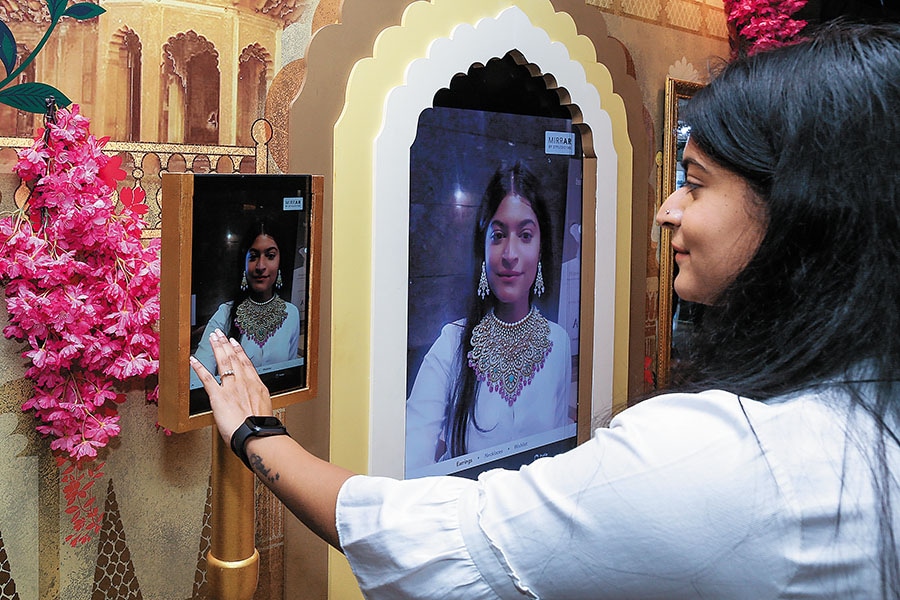 StyleDotMe’s platform, MirrAR lets customers virtually ‘try on’ jewellery at a store or kiosk, much like a Snapchat filter[br]For instance, StyleDotMe, a Delhi-based fashion-tech startup, introduced an augmented reality setup for the jewellery industry a year-and-a-half ago. Called MirrAR, the patented platform lets customers virtually ‘try on’ different pieces of jewellery at a store or kiosk, much like a Snapchat filter, eliminating the need for inventory at all chain stores and speeding up the customer trial process. MirrAR now works with 77 jewellers in 23 Indian cities, including Tanishq, Amrapali, PC Jewellers and Kalyan Jewellers. They recently did ‘zero-inventory’ kiosks for Tanishq at Delhi and Bengaluru airports, where flyers could browse through the brand’s collection, see how it looked on them, and generate leads.
StyleDotMe’s platform, MirrAR lets customers virtually ‘try on’ jewellery at a store or kiosk, much like a Snapchat filter[br]For instance, StyleDotMe, a Delhi-based fashion-tech startup, introduced an augmented reality setup for the jewellery industry a year-and-a-half ago. Called MirrAR, the patented platform lets customers virtually ‘try on’ different pieces of jewellery at a store or kiosk, much like a Snapchat filter, eliminating the need for inventory at all chain stores and speeding up the customer trial process. MirrAR now works with 77 jewellers in 23 Indian cities, including Tanishq, Amrapali, PC Jewellers and Kalyan Jewellers. They recently did ‘zero-inventory’ kiosks for Tanishq at Delhi and Bengaluru airports, where flyers could browse through the brand’s collection, see how it looked on them, and generate leads.
“Jewellery is a particularly conservative industry, where most jewellers are the third or fourth generation in the family,” says Meghna Saraogi, founder and CEO, StyleDotMe. “It’s tough to change their mindsets. The deal-breaker for us was an association we did with the Jaipur Jewellery Show early on, where we set up an experience zone through different domes. Customers move across the domes and, at eye level, see themselves in different jewellers’ inventories, without physically having to put anything on. After the show, about 30 jewellers paid us upfront.”
Saraogi recalls how one lady asked around to know who had built the zone, and finally found and hugged her. “She was so emotional, saying she never thought she would get a chance to see herself in such jewellery, but with this product, she finally had,” she says.
MirrAR uses various data points to make the jewellery life-like, including the height of the pieces and the quality of the diamonds used. The idea is to depict a piece exactly as it is, including its level of shine. Jewellers can add an unlimited number of images to their virtual inventory, and customers simply swipe and click to try them on. If they’re interested in a certain piece, it can be arranged to view physically.
“Jewellers typically show catalogues or pictures on their phones or iPads, and we realised that even a brand like Tanishq can’t have the same inventory at all its stores,” says Saraogi. “It’s so capital intensive for jewellery retailers, the biggest cost isn’t real estate, but the cost of transporting and securely storing inventory. We wanted to build something that would work seamlessly and solve a real pain point. Many other existing AR products worked on static images, or instruction-based technology, where a voice asks you to look at a certain angle, turn right or left, which a lot of customers don’t like.”
MirrAR also allows jewellers to create computer aided design (CAD) versions of jewellery sets for customers to try on, which can then be built in the real world based on feedback. “This closes the gap between real and virtual, as jewellers only have to manufacture the sets they know will sell, preventing wastage of both time and resources,” she adds.
According to Saraogi, an average customer tries on 20 to 25 pieces when using MirrAR, versus three to five with physical trials. “So our product is helping jewellers show 5x more SKUs (stock keeping unit) than they would have,” she says. “About 50 percent of people we surveyed say they feel awkward or tired after trying on five physical pieces at a store.”
StyleDotMe is working on launching similar AR solutions for beauty and sunglasses markets by the end of the year, and say the products are also helping jewellers penetrate newer markets.
“Initially, we targeted the big-brand jewellers who had multiple stores in Tier-1 and Tier-2 cities,” says Saraogi. “We were zapped to see the sort of demand we’re getting from Tier-3 and Tier-4 towns, where smaller jewellery stores take pride in being the first ones to launch such technology in their towns. They want to be projected as tech-savvy, progressive. We’re in places like Kota, Rajkot, Akola, and it’s amazing to see how people are responding there.”
StyleDotMe recently raised ₹2 crore in funding from Indian Angel Network and angel investors, in a bridge round led by Ambarish Raghuvanshi, former CFO, Info Edge, which runs various consumer internet portals. These funds will be used to bolster operations and set up a B2C web and mobile app, where customers can try on jewellery from various brands from their homes, and place orders on the StyleDotMe platform too. The company claims that its number of clients has grown by 40 percent quarter-on-quarter over the past year.
Jewellery isn’t the only traditional industry that technology is disrupting it is also spawning a new buzzy vertical in real estate called PropTech, still at a nascent stage in India.
In the luxury property domain, the challenges for the money-rich, time-poor clients are obvious—HNIs are by and large busy people, who may invest in multiple properties and may not have the time to visit each site they might consider. Brochures and websites can give a limited view. But using AR or VR, buyers can be ‘immersed’ in their projects in the next dimension, and take a walk around not just the property, but also its street, surroundings and so on. Interior projects can be monitored without site visits, and updates visualised in real time.
“Real estate, especially in India, has been slow to adopt technology, but this is rapidly changing,” says Abhay Kumar, head–marketing, JLL India, a real estate consultancy. “Now, technology is the top investment area for many real-estate players—developers know that they can’t keep doing business as they used to. It’s no surprise that a lot of startups who were earlier working on algorithms for IT players are now building solutions for real estate.”
JLL has partnered with the government’s Invest India mission to launch a PropTech accelerator, and claims to have received 1,500-plus registrations for the first round. Kumar says AR and VR sales experiences are far more effective than brochures and miniature 3D models, helping cut down the transaction process—but even more in demand will be the use of AI, machine learning and the Internet of Things (IoT) in this sector.
“From an occupier perspective, this segment has a far more direct use case, something you will interact with every day,” he says. “We’re seeing Alexa and Siri at all kinds of homes today, but in the luxury segment, things are taken a step further with automation.”
Using IoT-enabled devices, residents can not only map water wastage and energy efficiency in real time, but also control their home temperature, book parking slots, make sure the lift has arrived even before they reach the lobby, and so on. Luxury developers are investing in cloud-based visitor management solutions at projects too. “This is not something we are seeing in the middle segment, but the luxury segment has definitely started implementing it,” Kumar adds. “Think of the convenience and experience, and also the data insights you can draw using these, from both a buyer and seller perspective. These are no longer technologies of the future.”
Elementary, dear Watson
Tech giant IBM has been working extensively in building what it calls ‘cognitive fashion’. In 2017, it partnered with two major Indian fashion houses to stretch the limits of fashion tech, with the use of IBM Watson, its AI-enabled tool.
With fashion designers Falguni and Shane Peacock, IBM Watson worked to project the future of fashion. Using the Watson visual recognition API, the team scanned 600,000 publicly available fashion images from 2006 to 2017, from the world’s four biggest fashion weeks—London, Paris, Milan and New York. Similarly, they processed more than 5,000 major Bollywood outfits, and studied data from 3,000 Bollywood movie posters across the decades from the 70s to the noughties. IBM provided them with tools to identify colour, pattern and silhouette trends, and Watson could use AI to analyse thousands of patterns and create entirely unique ones for the future-collection, showcased at a fashion show to a standing ovation.
“We were lucky to have been the first few to work with AI, and it has opened up a lot of ideas on what we can do with technology,” says Falguni. “For example, if I was working on a purple dress, I could scan through the archives to see all the purple dresses showcased earlier so that I know mine is entirely new. This is one way in which designers and AI can work together… I wouldn’t say AI will take over the designer’s job, but it can make their lives dramatically easier.”
“Watson let us travel back and forth in time and space at an unbelievable speed, letting us study vast amounts of data for both broad trends, as well as an understanding of the more obscure data, too,” adds Shane. “We’re looking forward to extending Watson to other parts of the creative process because the future of cognitive couture is looking fabulous.”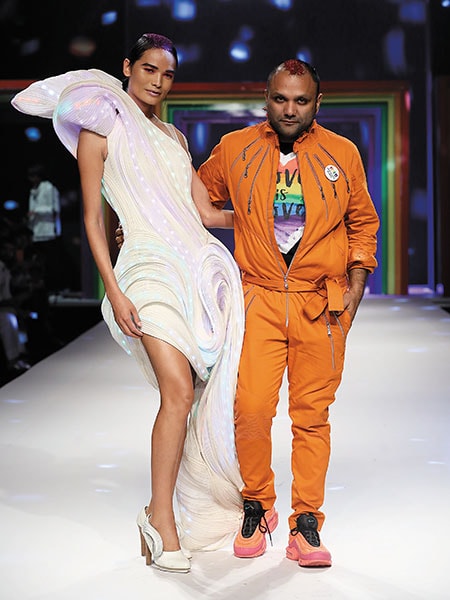 Designer Gaurav Gupta along with actor Archie Panjabi who’s draped in an AI sari that changes colours based on one’s personality[br]IBM also partnered with couturier Gaurav Gupta for a high-tech art-meets-fashion project: The world’s first AI sari. Powered by IoT, the white sculpted sari-gown had an LED light panel running across it, and the lights would change colours based on different personalities. The sari-gown featured as a live exhibit at the Vogue Women of the Year awards, worn by actor and the event’s emcee, Archie Panjabi.
Designer Gaurav Gupta along with actor Archie Panjabi who’s draped in an AI sari that changes colours based on one’s personality[br]IBM also partnered with couturier Gaurav Gupta for a high-tech art-meets-fashion project: The world’s first AI sari. Powered by IoT, the white sculpted sari-gown had an LED light panel running across it, and the lights would change colours based on different personalities. The sari-gown featured as a live exhibit at the Vogue Women of the Year awards, worn by actor and the event’s emcee, Archie Panjabi.
Using Watson’s personality insights API, the sari’s LED lights would change colour for each of the night’s awardees—a colour assigned after Watson conducted a detailed study of the person’s social media handles. Watson analysed social media activity using seven parameters, including effectiveness in organising thoughts, open-mindedness and originality, confidence and problem solving, action orientation, conscientiousness, openness to possibilities and alternatives and social energy. Each of these traits was mapped to a colour most associated with them. So, if Aishwarya Rai Bachchan was red, Shah Rukh Khan was gold. The gown was also used as an interactive art installation, where visitors could plug in their own Twitter handles and have the garment analyse their profiles and change to a colour assigned to them.
“What the experience taught me is that the future of design development is definitely technology,” says Gupta. “If I have a mood for love—say neon blue—it could come up with a million print ideas that can be customised in milliseconds. Any human developing that would take days, months. I’m toying with the idea of adding Watson to my design team it will add a different dimension to my design.”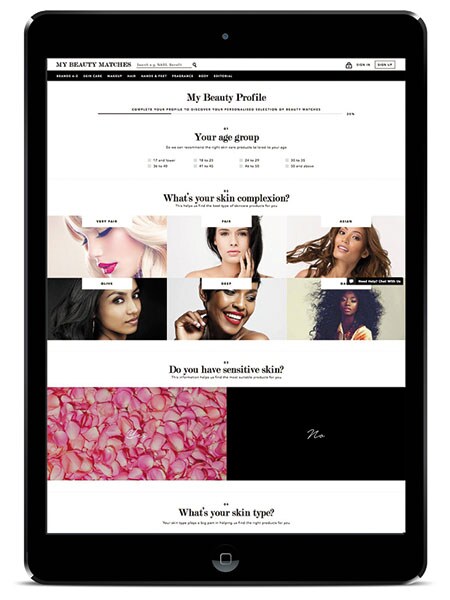 The BeautyMatchingEngine interface that helps personalise cosmetics for users[br]Brain power
The BeautyMatchingEngine interface that helps personalise cosmetics for users[br]Brain power
Imagine knowing what every customer is going to buy before they walk into a store.
A powerful line from a Deloitte report titled ‘Digital transformation–the ultimate challenge for the fashion industry’ pretty much sums it up. The report advocates digital transformation across fashion business functions and stresses the urgency and momentum to ‘re-imagine, reshape and retool for an era in which traditional boundaries are broken’.
Data is the new oil, but few companies know just how to use it. The report says ‘digital clienteling’, or leveraging user information at the convergence of big data analytics, IoT and data science, will help brands better tailor their sales information and products to customers, improving conversion rates and revenues. “A misaligned or generic digital offering may actually widen the digital divide and even pose a threat to brand and reputation,” it says.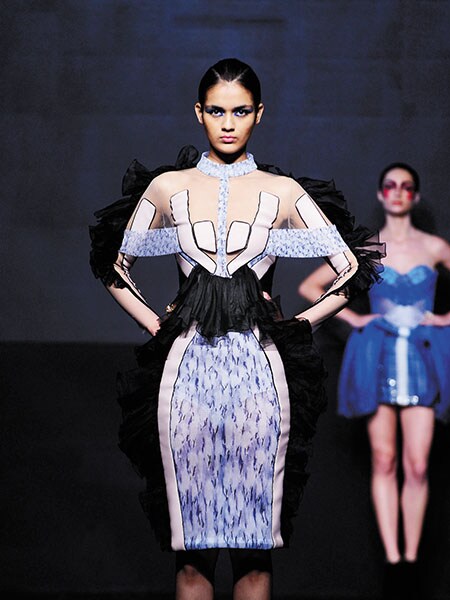 A model sporting a Falguni and Shane Peacock creation based on analysing user preferences
A model sporting a Falguni and Shane Peacock creation based on analysing user preferences
Image: Viral Bhayani[br]A few startups are seeing great interest in solving this problem for luxury brands. Vue.ai, for instance, formed in 2016, works on personalisation, product digitisation and increases the speed at which you can take a product online, for the fashion industry. It also helps analyse data to increase personalisations, which should eventually lead to conversions. The startup is based between Chennai and San Francisco, and services markets including the US, Europe, Latin America, Japan and the Middle East. Its clients include luxury fashion e-store Pernia’s Pop Up Shop, and it claims to have grown its revenue 3x over the last year. Vue.ai and its parent company, Mad Street Den, raised a Series B round of $17 million in April.
“This year, we’ve broken into India, and it’s become a pull market for us,” says Ashwini Asokan, founder and CEO, Vue.ai. “It’s interesting to see how the Indian customer is changing and driving this demand. You’re beginning to see the pull towards aggregation and storytelling. I can safely say that the era of the Flipkart-Myntra discounting driving the market is over.”
Asokan says about 10 to 15 percent of their total business now comes from India. “This is the year of luxury,” she adds. “Indians are now associating heavily with the value of a brand, between both beauty and fashion. Technology cannot create that demand, but it can create an order of magnitude growth. That’s where we’re focussed—how to send a customer the right thing at the right time.”
To explain, if you go on an ecommerce webpage, it is working quietly to understand you in real time. Are you looking at pink lehengas? Are you looking at pink lehengas with full sleeves? Or are you not looking at pink lehengas at all, but a particular type of embroidery, which led you to your first two clicks that happened to be on pink. “Every single click is specific to you,” says Asokan. “If a brand knows who they are producing for, they can influence production based on that, and stop wasteful creation. A lot of products get dumped because there’s no demand. When you’re spending that kind of money, you want each detail to be perfect, and brands must understand that.”
Similarly, London-based BeautyMatchingEngine (BME), run by its Indian-origin founder Nidhima Kohli, says India accounts for its third-largest volume of users. BME, an offshoot of its predecessor MyBeautyMatches, is a new AI-powered product for the beauty industry, which can help companies make hyper-personalised product recommendations to users.
“The beauty industry is behind many others on innovation, but it’s good with PR. It’s tough to make beauty recommendations, because each person might react to it differently,” says Kohli. “For example, we are both Indian, but we live in different climate conditions, we are of different ages and may have different concerns. What works for me will not work for you. Our product takes into account all these factors before filtering down them to recommendations.”
BME also analyses patterns—it noticed, for instance, that a lot of people buying shampoo for hairfall and dandruff also had acne concerns. “This is data the company can use, and we also help them explain to customers why a particular product is being recommended to them,” she adds. “Consumers are well-educated now in the beauty market, and companies are beginning to see that gimmicky experiences don’t generate revenue. Every touch point needs to count.”
“Ninety percent of people still think that personalisation is segmentation,” says Asokan of Vue.ai. “It’s 2019, that doesn’t work anymore. You can’t tell me that I am just like all these other people.”
First Published: Oct 15, 2019, 12:10
Subscribe Now